Introduction to Foundations:-
Foundation is an important part of the structure which transfers the load of the structure to the foundation soil. The foundation distributes the load over a large area. So that pressure on the soil does not exceed its allowable bearing capacity and restricts the settlement of the structure within the permissible limits. Foundation increases the stability of the structure. The settlement of the structure should be as uniform as possible and it should be within the tolerable limits.
Why we provide Foundations or Footings?
In simple words, Consider 1m3 of concrete weight i.e., 2400 Kgs to 2600 Kgs depending on mix. Think for a Two storeyed building how much concrete needed? How much quantity of bars needed? to construct a building. Foundation is to be strong enough to bear that all loads without any settlement, So for spreading the vertical load to large area footings are constructed.
Main Functions of foundations:-
- Distribution of loads
- Stability against sliding & overturning
- Minimize differential settlement
- Safe against undermining
- Provide level surface
- Minimize distress against soil movement
Depending on Soil bearing capacity of a particular location. Different Types of Footings are selected and constructed.
Different types of Foundations:-
Foundations are mainly classified into two types:
- Shallow Foundations
- Deep foundations
If depth of the footing is equal to or greater than its width, it is called deep footing, otherwise it is called shallow footing.
Difference between footings and foundations:
Footing is a part of foundation which is constructed with concrete or brickwork masonry and acts as a base to the floor columns and floor walls. The main function of footing is to transfer the vertical loads directly to the soil. The term footing is used in conjunction with Shallow foundation commonly.
Where We Provide Shallow foundation and Deep foundation?
Foundations may be shallow or deep foundations depending upon the load and type of foundation soil. If the load to be supported is very high and soil is of low bearing capacity, Deep foundations are provided. If the soil has adequate bearing capacity at reasonable depth then shallow footings are provided.
Below we have discussed about the different types of house foundations which we usually use for construction. Deep foundations and Shallow foundations are further classified into following types:-
Contents
- Introduction to Foundations:-
- Why we provide Foundations or Footings?
- Main Functions of foundations:-
- Different types of Foundations:-
- Difference between footings and foundations:
- Where We Provide Shallow foundation and Deep foundation?
- Shallow Foundations or Spread Foundations:-
- I. Isolated footing:-
- (i) Flat or Pad or Plain footing:-
- (ii) Stepped footing:-
- (iii) Sloped Footing:-
- (iv) Shoe or eccentric footing –
- (v) Combined footing:-
- Rectangular combined footing.
- Trapezoidal combined footing.
- II. Raft or Mat Foundation or footing:-
- How to decide which footing is to be adopted Isolated footing or Raft footing:-
- III. Strip foundation:
- Deep foundations or Pile Foundations:-
- Pile footings:-
- 1. Precast Piles:
- 2. Cast-in-situ piles.
Shallow Foundations or Spread Foundations:-
Spread foundations are used when the soil has sufficient strength within a short depth below the ground level. Shallow foundations need enough area to transfer the heavy loads to the base soil. As mentioned above, we chose shallow foundations when the soil has adequate Soil bearing capacity. Footings in Shallow foundations may be of Masonry, Plain concrete or reinforced concrete. The depth of shallow foundations are generally less than its width.
Different types of Shallow foundations are further divided into two types, depending on the soil bearing capacity:-

I. Isolated footing:-
Footings which are provided under each column independently are called as Isolated footings. They are usually square, rectangular or circular in section. Footing is laid on PCC. Before laying PCC, termite control liquid is sprayed on top face of PCC to restrict the termites to damage the footing. Isolated footings are provided where the soil bearing capacity is generally high and it comprises of a thick slab which may be flat or stepped or sloped. This type of footings are most economical when compared with the other kind of footings.
Advantages of Isolated Footing:-
- Economical when columns are placed at longer distances.
- Workmen with little or no knowledge can easily construct.
- Ease of Constructability:- Excavation, Form-work, Reinforcement placement and placing of Concrete is at ease.

(i) Flat or Pad or Plain footing:-
These kind of footings are generally square or rectangular or circular in shape which are provided under each column independently. Flat or Pad Footing is one of the Shallow Foundations. It is circular, square or rectangular slab of uniform thickness.
(ii) Stepped footing:-
These types of footings are constructed in olden days now they are outdated. As from the name its resembling that, footings are stacked upon one another as steps. Three concrete cross sections are stacked upon each other and forms as a steps. This type of footings are also called as a Step foundation. Stepped footing is used generally in residential buildings.
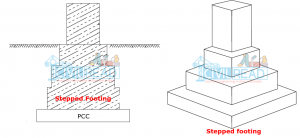

(iii) Sloped Footing:-
Sloped footings are trapezoidal footings. They are designed and constructed with great care to see that the top slope of 45 degree is maintained from all sides. When compared the trapezoidal footing with the flat footing, the usage of concrete is less. Thus, it reduces the cost of footing in concrete as well as reinforcement.
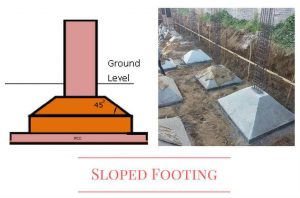
(iv) Shoe or eccentric footing –
Shoe footing is the half cut-out from the original footing and it has a shape of shoe. They are constructed on property boundary, where there is no provision of setback area. It is constructed at the corner of the plot when the exterior column is close to the boundary or property line and hence there is no scope to project footing much beyond the column face.. Column is provided or loaded at the edges of shoe footing. Shoe footings are constructed when the soil bearing capacity is 24KN/m2
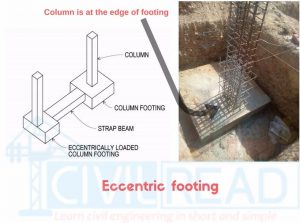
(v) Combined footing:-
A footing which has more than one column is called as combined footing. This kind of footing is adopted when there is a limited space. Due to lack of space we cannot cast individual footing, Therefore footings are combined in one footing. They are classified into two types based on their shape:
Rectangular combined footing.
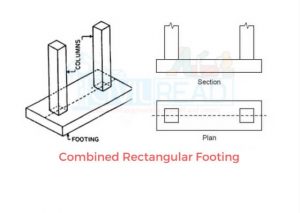
Trapezoidal combined footing.
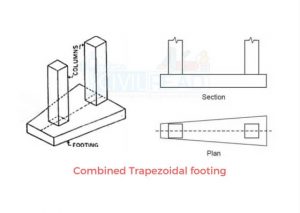
II. Raft or Mat Foundation or footing:-
When the column loads are heavy or when the safe bearing capacity of soil is very low, The required footing area become very large. As mentioned this footing is in shallow foundation. So in order to spread the load over large area with less depth then we have to increase the footing area. If we increase footing area the footings are overlapped each other, instead of providing each footing on each column all columns are placed in common footing. A raft foundation is a solid reinforced concrete slab covering entire area beneath the structure and supporting all the columns. Such foundation due to its own rigidity minimizes differential settlements.
It is provided in a places like seashore area, coastal area area where the water table is very high and soil bearing capacity is very weak.
When number of column in more than one row, provided with a combined footing, the footing is called mat or raft foundation.
How to decide which footing is to be adopted Isolated footing or Raft footing:-
- If the bearing capacity of the soil is very good and the super structural load is very small.. The use of isolated foundation is recommended.
- If the bearing capacity of the soil is very low, like less than 100 kpa( this isnt an exact number but it could be used as a boundary)
- If the super structural load to be transferred to the foundation is very high that the area of the isolated footing to be used is more than half the area covered by the building (this is recommended by Joseph.E Bowles)
- When we provide elevator in the building a separate raft may be provided on the elevator shaft.
- When the soil contains lenses ( or weak zones ) that should be bridged then raft might be used.
Raft footing does not have Neck column, they start directly From the ground surface but reinforcement of neck column starts from Raft.
III. Strip foundation:
Strip foundation is also called as Wall footing. As name itself showcasing that, it is a strip type footing which follows the path of Superstructure Wall. This type of footing is constructed for Load bearing walls. It is a continuous strip of concrete that serves to spread the weight of a load-bearing wall across an area of soil. The strip footing foundation width is decided by considering bearing capacity of soil. Greater the bearing capacity of soil lesser is the width of the Strip footing.
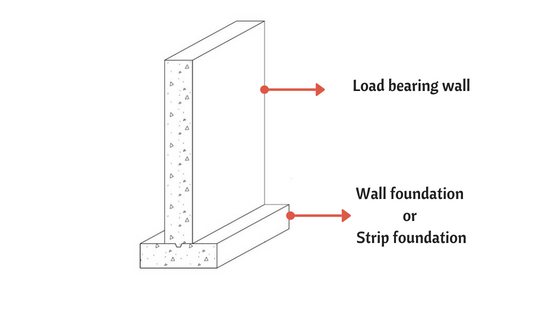
Advantages of Strip Footing:
- It doesn’t require expensive tools to construct.
- Easy to build
- Not required skilled labour to construct.
Disadvantages of Strip footing:
- Less durable when compared with other types of footings
- This type of footing is not suitable for specific types of soils
Deep foundations or Pile Foundations:-
If the depth of a foundation is greater than its width, the foundation laid is known as deep foundation. In deep foundation, the depth to width ratio is usually greater than 4 to 5. Deep foundations as compare to Shallow foundations distribute the load of the super structure vertically rather than laterally. Deep foundations are provided when the expected loads from superstructure cannot be supported on shallow foundations.
Pile footings:-
A pile is a long vertical load transferring member made of timber, steel or concrete. In pile foundations, a number of piles are driven in the base of the structure.
They are constructed where excessive settlement is to be eliminated and where the load is to be transferred through soft soil stratum, where the Soil bearing capacity is sufficient. These types of footings are provided when the Soil bearing capacity of soil is very weak and the Ground water table (level) is high. These types of the footings are generally designed on sea shore areas, bridges to construct pillars, etc.
- Pre cast Piles.
- Cast-in-situ piles.
1. Precast Piles:
The Pre-cast concrete piles are usually reinforced or Pre-stressed concrete piles. These piles occupies more space for casting and storage, and takes more time to set and cure. The precast concrete piles are generally used for a maximum design load of about 800 kN except for large Pre-stressed piles. The length of precast concrete piles varies from 4. 5 m to 30m. The Pre-stressed concrete piles as compared to Pre-cast and reinforced concrete piles are lesser in weight & easy to handle having high load carrying capacity and are extremely durable.
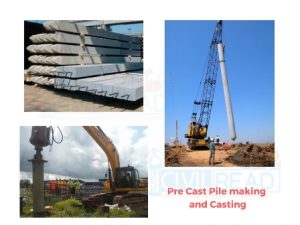
Advantages of Precast Piles:-
- Reinforcement provided in Precast piles are not liable to change it place and disturbed.
- The cost of Precast piles manufacturing is less because large number of precast piles are manufactured at a time.
- The defects in pile can be easily identified after the removal of formwork, and these defects (such as presence of cavity or hole) can be repaired before driving the pile in site.
Disadvantages of Precast Piles:-
- These pile are heavy so it requires special equipment to carry and transport the pile to site.
- Sufficient care must be taken at the time of transportation, otherwise piles may break.
- For embedding these piles in field, heavy pile driving equipment is required.
- These piles are costly as extra reinforcement is required to bear handling and driving stresses.
- Post insertion of pile in ground it is not possible to increase the depth of pile. As the length of the pile is restricted.
2. Cast-in-situ piles.
The piles which are casted on site. And don’t require any transportation is called cast-in-situ piles. The cast-In-situ concrete piles are casted in position inside the ground and need not to be reinforced in ordinary cases. These piles are not subjected to handling or driving stresses. The cast- in-situ concrete piles are generally used for a maximum design load of 750 kN.
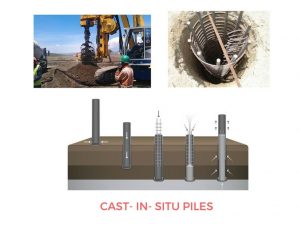
For Instant updates Join our Whatsapp Broadcast. Save our Whatsapp contact +9700078271 as Civil Read and Send us a message “JOIN”
Never Miss an update Click on “Allow us” or Red notification bell at bottom right corner and allow notification. Stay tuned! More are updated Soon!!.
Civil Read Wishes you ALL the BEST..

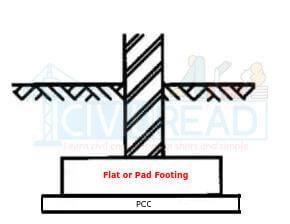

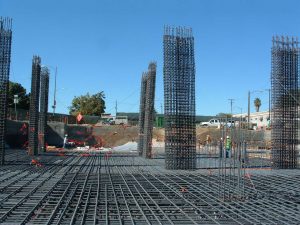

I am abdul from India Goa.. Plz aad me ur whatsup grp or channels my number
9860707537…
Hey abdul,
Please fill the form at below to be added in Civil broadcast for Updates
Stay connected with Civil read
Nice book Krishna . thank you n keep it up
Thank for giving me important thing
Hello Sir, Thanks for sharing good information. Can I get sbc for crane operations?
Tysm sir for the information u have given
Its a very basic information which are very helpful to decide a right type of foundation to how choose. For over best construction and economic construction
absolutely amazing krishna.
really useful..thank u
Hi, the above mentined whatsapp number is not on whatsapp
please update a whatssapp number.
whatsapp working use correct number
Tysm for sharing this blog ?
Thanks for Your inputs. 🙂
Very good informatiom Krishna
Thanks a lot for this important article about different types of foundations, it helped me to clear my doubt about this topic.
Thank you.
thats great i solved your query. Thanks for ur comments rahul.
Stay tuned with civilread family
SBC in KN/M3 ?????? …it must be KN/M2
its KN/m3
my whatsaap no is 8697068341. i have a project on mounded bullet design for that i want to design the footing but i am not able to decide which footing is suitable. service load is 74538.601 KN and area is (75m*54m). so please add me in your whatsaap group and please help me.
and soil bearing capacity is 300 KN
can u plz elaborate ur query
thank you for providing very important data in a clear, short and pricise manner
thank u for this important data
wow amaizing seriously i am cleared now from confusion .. thanks alot
Dear Brother Krishna,
I am Rasheed, living Chennai. I constructed home (Ground Floor + First Floor) by giving on contract when there is no building surrounding it. Now the neighboring land owner complained that the footing of the column is lying in their plot though the building is well within our admitted area. Now they want to cut the footing of our column as they are going to construct house. Will it have impact on the building? or is there any other solution without cutting the footing? Please give your valuable suggestions in this regard.
Regards
Rasheed
hi i request you to post ur query on forum.civilread.com with images if possible
make it strap footing. so that it is in the boundary line
Its awesome platform to learn about civil engineering. I am working as asst.prof, i told my students to follow this webpage. can you add me into your whats app group..?
thank u sir
hello, if i were to design a mid rise hospital building (4-5 storeys) on a soil with low bearing capacity, what type of foundation is the best to use?
Thanks for sharing the information Sir
Can I get calculation of step footing in case base length not mentioned
Pls, I want u to add me to ur platform on WhatsApp. I have try adding ur number but I can’t see ur number on my contact list in WhatsApp. Thanks
add +91 before the number
great work krishna sir
Hai,
I am Geotechnical Engineer. This is nice platform to share knowledge.
thanks for ur comments
Sir, How i connect with u?
[email protected]
Hi Krishna, this is Prakash am having a site to discuss with u, can u plz share ur no, thq u in advance.
If u have any specific query post ur query on forum.civilread.com if not ping me on whatsapp 9700078271
Dear Mr.Krishna ,
Please add me my number 00971522868086
pls also add me to whatsapp grp…
my numbr is 9496433751
Please add my number in group 7010527510
It is really awesome , it is conceptual , it makes me to know lot related to foundation , and the way to explain is an also excellent.
Nice one sir keep it up diz forum has really helped me in my project work
Hello sir..
I am manawer Ali.. please add me sir
good explanation and clear.. i want to join whatapp group for my study
Can we use M25 design in footing and M35 in column in G+3 Building
it depends on soil conditions
Comment Text*I’m kashimu pls ad me to WhatsApp group for more idea
Hi!
While browsing the net, i happened to stumble upon your website. Indeed a real good initiative Mr. Krishna. God bless you and your mission.
Usman from Nigeria thanks so much I really enjoy this website 👍
Glad that i helped you
Very importance basic topic . thank you for this knowledge.
very good. itz very useful. thx